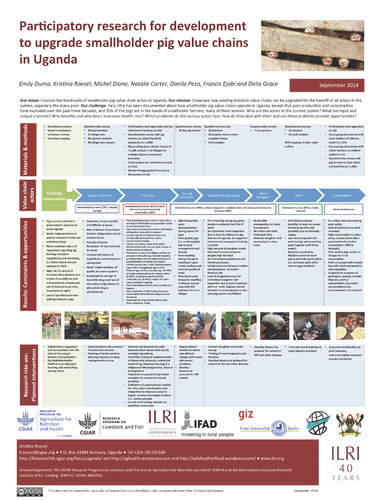Participatory research for development to upgrade smallholder pig value chains in Uganda
Abstract
Our vision is to improve the livelihoods of smallholder pig value chain actors in Uganda by
showcasing how existing livestock value chains can be upgraded for the benefit of all actors in
the system, especially the many poor. Very little has been documented about how pig value
chains operate in Uganda, except that pork consumption has exploded over the past three
decades and is foremost in sub-Sahara Africa today. Who are the actors in the current system?
What are the input and output channels? Who benefits and who bears economic and
health risks? Which problems do the various actors face, how do they deal with them and can
these problems provide opportunities?
In a multi-disciplinary and overarching gender-disaggregated approach and with the help of
numerous local partners we conducted an initial scoping of different pig value chain systems
through participatory rural appraisals with 1,400 farmers and interviews with more than 300
key informants. This was followed by in-depth questionnaire surveys with 1,200 households
and more than 300 other value chain actors. Screening of more than 1,000 pigs and pork at
different nodes of the value chain for pathogens aimed to complete the assessment.
Eighty per cent of the pigs are kept by smallholder farmers and piggery is a primary income
generator, especially in peri-urban areas. We found that most of the constraints are related
to lack of knowledge and prerequisites: pig keeping is not a traditional livestock activity in
Uganda, and farmers do not have a sound understanding of good husbandry practices and have
poor access to advisory services about the components for pig breeding, feeding and health
management. Entrepreneurs venturing into the market at all stages of the value chain lack the
necessary experience and equipment. The value chain is highly fragmented and underutilised.
Interventions will focus on capacity development of the various value chain actors in conjunction
with piloting of technical and institutional related interventions on select aspects that
mainly target women, who bear 60% of the workload involved in piggery, and the youth who
are involved in the post-production nodes of the value chain.

